#Siva Vishnu Stotra
Explore tagged Tumblr posts
Text
Shiva Stotra With Vishnu's Dwadasanama
Shiva Stotra With Vishnu’s Dwadasanama
Bhagwan Sri MahaVishnu ,in one of His manifestations, is Aditya ,born of Sage Kasyapa.He declares in Srimad Bhagavad Gita ‘ Adityaanam aham Vishnu ‘,I am Vishnu among the Adityas. Adityas are twelve. Surya, the Sun, is the Eldest. In this sense , Surya,Sun, is the Jyeshta,Elder, to Vishnu.It may be noted that Suryanarayana is called the Visible Reality,Prataksha Brahma. Therefore many things…

View On WordPress
#சிவ வழிபாடு#சிவா விஷ்ணு சஹஸ்ரநாமம்#Dwadasanama#Kaapalika Stuthi#Siva Dwadasanama#Siva on Vishnu Vishnu on Siva#Siva stotras#Siva Vishnu Stotra#Siva Vishnu temple#Vishnu stotras
0 notes
Text

Lalitha Rahasyam
Befitting the title as Hayagreeva said Lalitha Sahasranama is an unfathomable treasure of “Rahasya”. If you unleash your imagination, each nama will offer you “sahasropari” ardhas (meaning). It is a bhava-sagaram. One can write 1000 words on each nama vaibhavam. Prathi akhsaram in a nama is a amrutha-bandam.
Take for instance the nama “Uma (633)”, which offers a myriad of upa-kadha. Uma as we know is the wife of Mahesvara and therefore they are famously known as Uma Mahesvara/Umamaheswari. She was born to Himavan. She started her penance at the age of five to attain Mahesvara as Her husband. As Her mother Mena prevented from her doing such a great penance at an young age she came to be known as Uma. U Ma means do not practice. The Siva Sutra names her as “Ichasakti Uma Kumari.”
Siva is pranava swaroopam – Om. This kara, ukara, makara, nada bindu samyuktham. Uma is the mirror image of Siva. She begins from Siva, the bindhu, her japa is for Siva (nadha), ukara,akara makara sammelan is Uma.
Linga Purana further says: The goddess born of Rudra’s body rebuked Daksha and was born as Uma, as the daughter of Himavan.
Uma refers to a deity that was once worshipped in Kasmira nagara according to the Nilamata Purana. Uma was originally blue-complexioned because she is Giri-raja puthri. She became fair after severe penance to attain Sankara. Her worship is prescribed on various occasions under different names such as Durga, Symala, Sathi, Bhadrakali etc. Vegetables, fruits, roots, meat, various kinds of drinks, lamps, jewels, garlands, clothes, incense etc. are offered to her.
Regarding the name Sathi, the Siva Purana, Brahma narrated to Narada: Daksha named his daughter Uma since she inherited good qualities and was greatly admired.
She is worshipped for a happy family. She is also known as Ambika and Rudrani.
An interesting episode in Uma’s life shows her compassion for another stree. Going with her father to Siva's house, they met Rati Devi weeping. She said that Siva had burnt down her husband Kama Deva (Manmadha). On this Uma's father did not like the idea of giving his daughter to such an ill-tempered person. Uma requested permission to do penance and was allowed. Indra at this time thought of the seven sages to bring about Siva's marriage with Uma. The sages were satisfied of her steadfast love to Siva and had his consent for the marriage; celestial women dressed Uma, as also the Siva; amidst divine music, the couple went to the city of Mahagirinagara and Brahma officiated as priest. After the marriage they left for Mandaragiri.
Uma is also mentioned as one of the 24 avataras of Mahalakshmi accompanying Narayaṇa. This particular manifestation couples with his counterpart form called Janrdana and together they form the 18TH celestial couple, according to the Pancharatram.
Uma Maheswara sotram makes no difference between Parvathy and Uma, though the name of the stotra addresses Uma. It begins with Nama Sivabhyaṃ Navayauvanabhyaṃ
parasparaslishṭa Vapurdharabhyaṃ Nagendrakanya Vrushaketanabhyaṃ namo nama Sankara Parvatibhyaṃ
The Rudrahridaya Upanishad mentions Uma. It asserts all Devas are manifestations of Rudra Siva, and all Devis are manifestations of Uma. They are inseparable, in forever union. Those who worship Siva, are worshipping Vishnu. Rudra is full of Vishnu and Brahma. Uma is same as Vishnu. The masculine is Siva, asserts the text, and the feminine is Uma. What moves in the universe, is just Rudra-Uma manifestation, Dharma is Rudra, world is Vishnu, knowledge is Brahma, all is inseparable.
Rudra is man, Uma is woman.Rudra is Brahma, Uma is Sarasvati.Rudra is Vishnu, Uma is Lakshmi. Rudra is the Sun, Uma is shadow. Rudra is the Moon, Uma is star. Rudra is day, Uma is night. Rudra is Yajna, Uma is Vedas. Rudra is Agni, Uma is Svaha.Rudra is Veda, Uma is Sastra. Rudra is scent, Uma is flower. Uma is the word. Rudra is its meaning. My prostrations to Him and Her.
3 notes
·
View notes
Photo

SHIVA TANDAVAM- DANCING, Anand Manchiraju
SIVA TANDAVAM (DANCING) LARGE ACRYLIC PAINTING Lord Shiva is Parmeshwar, Supreme personality,Jagad Guru, Jagat Pita, after Lord Vishnu. He is the Master of all Graha Nakshtras and Bhoot Pret, Pisach and other Supernatural Powers. All are under his command. That is why, he is also named as Bhuteshwar and Nageshwar. He is also the king of all dancing knowledge & is an expert in the thandava dance. He is also named as Natraj. Story Behind Tandav Dance:- Once the King of demons of Lanka, proud Raavan conquered the entire earth and he even approached Mountain Kailas on top of which Lord Shiva resides with his consort Goddess Parvati. Raavan used to go to Kailash Parvat every day for the darshan of his Lord Shiva. Lord Shiva was also pleased with his Bhakta Raavan. So, Raavan reached Kailah and called Lord Shiva to come down. But Lord Shiva was busy in his meditation so, did not care at the word of Raavan. Enraged much at this attitude of Lord Shiva, Raavan uprooted the mountain Kailash with his twenty hands. When Mata Parvati watched this action of Raavan, she became raged. But Lord Shiva noticed this scenerio in his meditation and he pressed down the mountain with his right feet toe. At the pressing of little side of toe, Ravana hand was crushed by the weight of the mountain. Raavan immediately accepted his fault before Lord Shiva and began to sing Stotram in praise of Lord Shiva. At the Stuti of Raavan, Lord Shiva was pleased and pardoned the fault of his Bhakta. Raavan sang the song from Sama Veda and this great stotra composed by him is called Raavan Stotram also. At this, Lord Shiva began to dance that is called Tandavam. This is unique and vigorous style of dancing. When Lord Shiva was pleased or enraged, he danced in very strange situation is called Tandavam. When Lord Sri Ram worshiped him, at Rameshwaram, Lord Shiva was pleased and danced. When Sri Krishan reached the top of mountain and worshiped Lord Shiva, he danced in strange style is called Tandavam. Once he had danced in difficult situation for killing of demon. Such dance is not possible for any other god. /Jai Sri Ram/
https://www.saatchiart.com/art/Painting-SHIVA-TANDAVAM-DANCING/1092710/4363486/view
3 notes
·
View notes
Photo
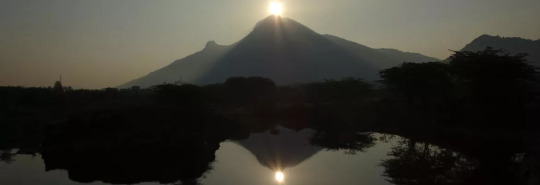
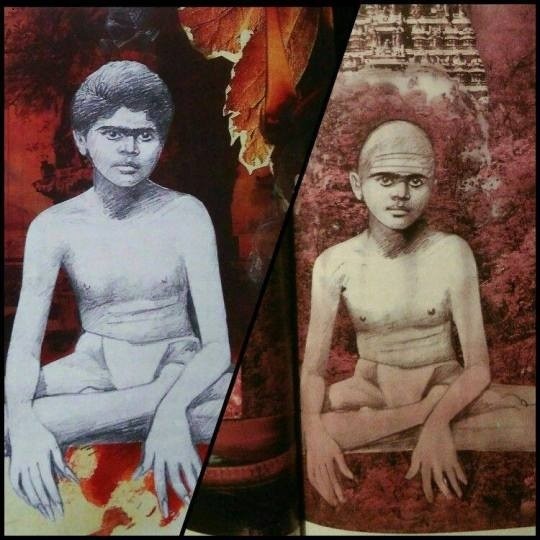
https://www.davidgodman.org/bhagavans-deposition-on-arunachala/
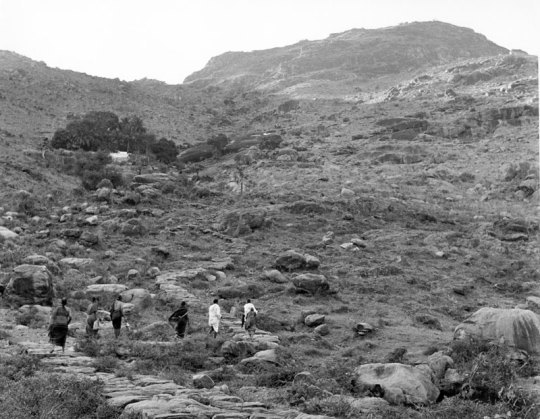
A 1949 view of the path to Skandashram on the eastern slopes of Arunachala. Near the top of the photo is the clump of trees around Skandashram.
☀
In the late 1930s Bhagavan made a legal deposition on behalf of the Arunachaleswara Temple which was fighting to retain control over a portion of Arunachala. In his submission Bhagavan spoke about his own relationship with the hill and provided evidence of the historical sanctity of the mountain.
☀
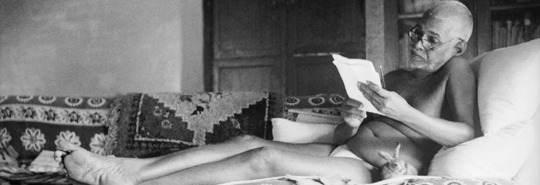
Bhagavan’s Deposition on Arunachala - I
Until the 1930s the eastern slope of the mountain of Arunachala was administered by the Arunachaleswara Temple in Tiruvannamalai. Prior to 1934, its right to do so had been accepted by everyone on and around the hill. From time immemorial the temple authorities had maintained the tanks and temples on the mountain, put out any fires that broke out, and arranged for all the forest produce to be sold in an orderly manner. The unquestioned authority that the temple authorities had wielded over this area had arisen because of the local tradition that the hill was Siva Himself manifesting in the form of a lingam. Since the belief was widespread and largely unchallenged, the local people felt that it was natural and correct that the main temple in Tiruvannamalai should administer all affairs pertaining to the hill.
This traditional arrangement was challenged by the Government of India in 1934. In May that year the Government issued a notification in the district gazette which stated that the whole of Arunachala was a reserve forest and was thus the property of the Government of India. The temple authorities challenged the Government’s order in court, maintaining that the temple was the legitimate owner of 1,750 acres on the eastern side of the hill. This area included all the tanks and temples on the slope of the mountain that begins at the back of the Arunachaleswara Temple.
One of the temple trustees approached Bhagavan and requested him to give evidence to the court that would support the Arunachaleswara Temple’s claim to the land. Bhagavan agreed and in 1938 lawyers for the plaintiff and the defendant came to the ashram to hear his evidence and to cross-examine him on it. Bhagavan’s initial evidence took the form of a written deposition. A small part of this deposition was recorded in Talks with Sri Ramana Maharshi, talk no. 492. The full text is given below.
I came to Tiruvannamalai in the year 1896 and lived on the hill from 1899 to 1922. In that year this ashram was started, and since then I have been living here [at Sri Ramanashram]. From the time I first lived on the hill, all the hill areas have been in the possession of the Devasthanam [the Arunachaleswara Temple authorities]. The ashram on the hill where I used to live was started in 1902. The building which is there now was completed in the year 1916. This particular ashram was built with the permission and kindness of the Devasthanam. [The permission was oral, for no written Government order or permission was ever received]. From the year 1899 until a date a few years after I left Skandashram, the front side [the eastern slope] of the hill was never in the possession of the Government.
Having given his views on the ownership of the hill, Bhagavan then cited a few examples of how well the temple authorities had administered the hill during the period when he had been living on it.
[Many years ago] a man called Saraswathy Swami lived on the hill. That Swami advertised that he intended to perform a ceremonial worship of an image of Lord Subramania [on the hill]. The Devasthanam objected and stopped it. In an official notice they said that the hill itself is linga swarupa [God in the form of a lingam] and that to perform worship of another deity on it, and to celebrate a festival there, was against the tradition of the sastras. On another occasion, when my mother attained [samadhi], they raised a precautionary objection that her samadhi should not be on the hill. They feared that we might build her samadhi on the hill itself. On this occasion also their objection was that the hill was Iswara swarupa [God’s own physical form].
In those days the Devasthanam authorities gave out orders that the wood cutters should not cut the trees on the hill. Every year during the time I was on the hill the Devasthanam gave licences to various people to cut the grass and to collect the other forest products. Whenever there was a fire on the hill, it was put out at the expense of the Devasthanam. On one occasion when we happened to cut some of the cacti that were causing an inconvenience to the ashram, and then burned them, the Devasthanam objected, saying that we should not have a fire in that place. All these incidents took place on the eastern slope. This eastern slope has fixed boundaries.
Bhagavan then went on the describe why the hill was sacred and why, in his opinion, the temple authorities should be allowed to administer it.
There is an aitikya [tradition] that this hill is linga swarupa, that is to say, that this hill itself is God. This aitikya is not to be found anywhere else. That is the cause of the glory of this place. The tradition of this place is that this hill is the form of God and that in its real nature it is full of light. Every year the Deepam festival celebrates the real nature of the mountain as light itself. Authority for this is found in the Vedas, the Puranas and in the stotras [poems] of devotees. Because this tradition maintains that this hill is Siva swarupa, the practice of giri pradakshina, walking clockwise around the mountain as an act of reverence or worship, has arisen. I also have faith in giri pradakshina and have had experience of it.
There is no sastra to separate the hill from the temple. The inseparability of the hill and the temple can be observed during Kartikai Deepam when the festival [of kindling the light] is conducted simultaneously in the temple and on the summit of the hill. Further proof of the tradition that the hill is the form of God can be found in the bi-annual festivals in which the image of Arunachaleswara in the temple performs pradakshina of the hill.
In the account in Talks with Sri Ramana Maharshi Bhagavan is reported to have also said:
‘Siva always remains in three forms: 1) as parabrahman; 2) as linga (here as the hill); and 3) as siddha.’
The third category refers to Siva in the form of Arunagiri Yogi whom Bhagavan said resides on the north slope of the hill. Although this quotation summarises views that Bhagavan had expressed on other occasions, there is no record of this remark in the court transcript.
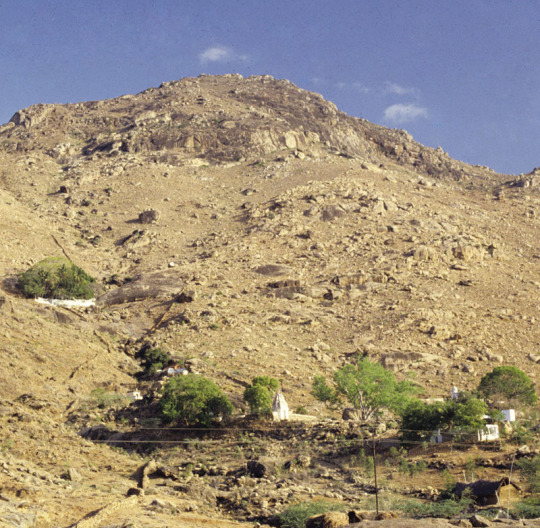
The bare eastern slope of Arunachala around 1980. The trees midway up the photo on the left are the ones at Skandashram. The gopuram in the centre, near the bottom of the photo, is the entrance to Guhai Namasivaya Temple.
Bhagavan continued:
In accordance with the tradition that the hill is Iswara swarupa, the Devasthanam performs abhishekam to the top of the hill in the same way that it would do to a lingam. For the last ten to twelve years the cauldron that contains the Deepam light on the top of the hill is carried to the summit every year during the festival. Prior to this, for many, many years, the cauldron was left there throughout the year.
I am a devotee of Arunachaleswara. I have composed a poem in Tamil which says that the Arunachala hill is Iswara swarupa.
The Government’s lawyer objected to Bhagavan introducing this poem as evidence, but the objection was overruled. It seems that no one recorded the original Tamil verse. It now only exists in the following English translation:
Lord Arunachala appeared out of the hill and at the request of Brahma and Vishnu merged back in the hill. Simultaneously he manifested as the lingam at the bottom of the hill. The hill continues to represent the Lord.
A similar idea, which may be derived from this verse, can be found in the account in Talks with Sri Ramana Maharshi:
‘Siva originally appeared as a column of light. On being prayed to, the light disappeared into the hill and manifested as [a] lingam. Both are Siva.’
After Bhagavan had submitted his verse, the case was adjourned for five days. On its resumption, Bhagavan added a few extra comments on the traditions and mythology of the hill.
Even after this [the time when Siva appeared to Brahma and Vishnu in the form of Light] Ishan [Iswara] appeared to Devi in the form of Light before disappearing graciously into the form of the hill.
There are many ancient tirthams [sacred tanks] that exist on the hill. Among them the Mulaipal Tirtham and the Pada Tirtham, are important. There is a tradition that these tirthams were created by Siva and Parvati for the sake of Guhai Namasivaya.
The Government’s lawyer then began his cross-examination of Bhagavan, questioning him in detail on some of the statements he had made. Only Bhagavan’s answers are recorded in the court transcript. I have separated the text into paragraphs in such a way that I hope each paragraph constitutes a different answer. I leave the reader to infer what the questions might have been.
I lived in Virupaksha Cave for sixteen years. I lived in Skandashram for six years. I have stayed at this place [Sri Ramanashram] since 1922.
I constructed a building at Virupaksha Cave. No written permission was obtained from anyone for the construction of the building.
Skandashram was started in 1902. The building was completed in the year 1916. Even after that date some construction work was carried on.
At first it [Skandashram] began as a tirtham. Later it developed into a place of residence. Before Skandashram came into existence, moisture was found in another location nearby. Its source was in a rock that was twenty yards away. This tirtham is now located between Skandashram and Virupaksha Cave. It was only later that the Skandashram tirtham came into being.
Because it [Skandashram] was built by a person called Kandan who lived in the ashram, by his own hands, it became known as Skandashram. That tirtham [I just spoke about] is attached to that ashram.
No order was received from anyone for building this ashram [Skandashram]. Because I was staying there, no one objected. On the contrary, they approved of it.
During the time I lived on the hill, no written order was ever obtained from anyone to make living facilities. Nor was any order obtained when repairs were carried out in some of these places.
They were not done on my authority; others did them as their own work. I did not tell them to build, nor did I prevent them. In this manner Skandashram, Virupaksha Cave and Sri Ramanasramam came into being. The other ashrams on the hill also came into existence in this way. No written orders were received for their construction.
I knew about the notice issued to Saraswathy Swami by the Devasthanam. But I do not remember the year in which it happened. I heard that the notice had been given.
During the period I was on the hill, a vel [spear] and a statue were in the temple [of Subramania]. They [the Devasthanam] did not object to the statue being kept in that place; their objection was to popularising it through public celebrations.
There are places to stay both at Virupaksha Cave and Guhai Namasivaya Temple. It is not known whether they contain the samadhis [of the two saints who founded them]. In Guhai Namasivaya there is a lingam. In Virupaksha Cave there is an altar. In Guhai Namasivaya puja and abhishekam are done to the lingam. At the altar in Virupaksha Cave, only puja is done. It is the popular belief that both of these places are samadhis.
The time when Virupaksha Deva and Guhai Namasivaya attained samadhi may be around 300 or 400 years ago. I do not know when the buildings were first started in those places.
It is stated in the Upanishads and in the Skanda, Linga and Siva Puranas that this hill is Iswara swarupa.
I cannot say without referring to the books in which Upanishad and in which place it is stated so.
There was a jadai swami [a swami with long matted locks] who used to live on the hill. He died there. His body was brought down to the foot of the hill and interred. The same thing happened to Palaniswami. A samadhi cannot be made on the hill for anyone who dies there. They can only be burned after bringing them to the foot of the hill. Once a person died near Seven Springs [two thirds of the way up the mountain]. His samadhi was also made at the foot of the hill.
Jadai Swami attained samadhi about four of five years ago. The others attained samadhi after 1901 and before 1920.
I had no thought of having my mother’s samadhi on the hill. I did not tell anyone that the samadhi should be made on the hill.
I have omitted several of Bhagavan’s answers. Some of them merely repeat what he said earlier while others pertain not to Arunachala but to rather mundane matters of ashram administration.
~ David Godman
☀ ☀ ☀ Continues in “Bhagavan’s Deposition on Arunachala - II”
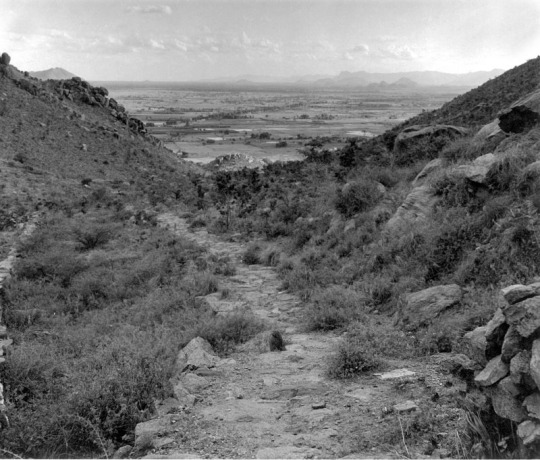
The path from Skandashram to Ramanasramam before it was reforested in the 1990s.
☀
#Bhagavan Sri Ramana Maharshi#David Godman#Arunachala#Bhagavan’s Deposition on Arunachala#Guhai Namasivaya#skandashram#virupaksha#Iswara swarupa#God in the form of a lingam#linga swarupa#Arunachala Linga#The Holy Beacon#Karthigai Deepam Festival#festival of lights#pillar of light#jyothi#jyoty#Skanda Mahapurana#Siva Mahapurana#Arunachala Mahadeepam Cauldron#cauldrom#giri pradakshina
11 notes
·
View notes
Text
Inkyz Shiva Mp3 Free Download

Inkyz Shiva Mp3 Free Download Pc
Inkyz Shiva Mp3 Free Download 6 0 4
Inkyz Shiva Mp3 Free Download Youtube
Siva Deeksha Gaanam Mp3, Shiva Ganam by Hema Chandra, Nitya Santhoshini. (49.74MB) Mp3 Download, Download Link Lord Shiva Songs - Nagendra Haraya Trilochanaya - Siva Deeksha - JUKEBOX - BHAKTI SONGS Mp3 Song and MP4, 02 SIVA DEEKSHA I Kannada Downloader, Siva Deeksha Gaanam Convert from Mp3Juice. Lord Shiva Mantra Maha Mritunjay Mantra Free MP3 Download. Lord Shiva Picture. Recently I launched the new mantras series, in which I bring you the greatest and most powerful mantras to help you with your spiritual growth and life evolution. Inkyz – shiva (ft. M.i.m.e) mp3 download. دانلود آهنگ Inkyz – Shiva (ft. M.I.M.E) ادامه و دانلود. ☯ Tribal Spotify playlist: ☯ Stream Inkyz - Shiva ft. M.I.M.E.: ☯ Tribal Trap: x https://www.
Shiva is the god of the yogis, self-controlled, while at the same time a lover of his spouse (shakti). Lord Shiva is the destroyer of the world, following Brahma the creator and Vishnu the preserver, after which Brahma again creates the world and so on. Destruction opens the path for a new creation of the universe, a new opportunity for the beauty and drama of universal illusion to unfold.
Advertisements
He is responsible for change both in the form of death and destruction and in the positive sense of destroying the ego, the false identification with the form. All that has a beginning, must have an end. Thus the power of destruction associated with Lord Shiva has great purifying power, both on a more personal level when problems make us see reality more clearly, as on a more universal level.
Forms of Shiva
Shiva has many forms, which are visible in his Panchavaktra form with 5 heads, a combination of all Shiva energies : Aghora (resides in the creamation grounds), Ishana (most often appears as the shivalingam), Tat Purusha (meditating), Varna Deva (the eternal Shiva) and Saddyojat or Braddha Rudra (the old wrathful form). The last also forms the connection to the Rudraksha mala – a rosary made of the dried fruits of the Rudraksha tree.
Another form is the Nataraj. Shiva Nataraj‘s dance represents both the destruction and the creation of the universe and reveals the cycles of death, birth and rebirth. His Dance of Bliss is for the welfare of the world. In the pose of Nataraj, the King of Dance is giving darshan to his beloved devotees within the “Hall of Consciousness”, which is the heart of man. Under his feet, Shiva crushes the demon of ignorance called Apasmara Purusha, caused by forgetfulness. One hand is stretched across his chest and points towards the uplifted foot, indicating the release from earthly bondage of the devotee. The fire represents the final destruction of creation, but the dance of the Nataraj is also an act of creation, which arouses dormant energies and scatters the ashes of the universe in a pattern that will be the design of the ensuing creation.
Yet another manifestation of Lord Shiva is said to be Hanuman, the ultimate karma yogi, in never-ending selfless service to Ram. The fact that this is not really clear can be perfectly explained by the understanding that a true karma yogi will never take the credit for his acts, as they would otherwise not be entirely selfless. The ego would still get the credit. So, in order to respect Shiva as a true karma yogi, let us not pay too much attention to this manifestation.
Download free mp3 of Shiva bhajan:
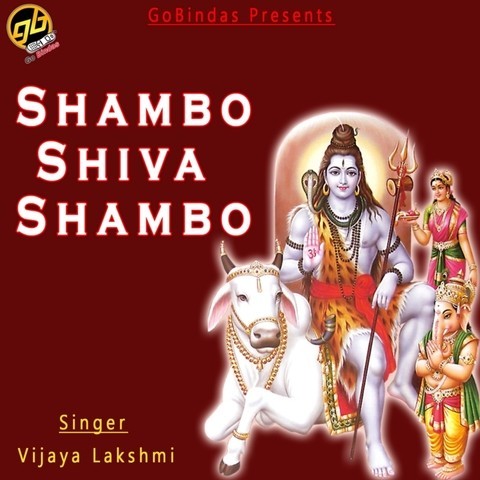
(Right Click and save as)
[downloads query=”limit=30&category=23&orderby=hits&order=DESC” format=”2″]
More Shiva Bhajan Albums Album
Jaya Kishori – Shiv Stotra Jaya Kishori – Nache Bhole Ke deewane Sanjay Mittal – Om Namah Shivay Shyam Agarwal – Sabse Bada Khiladi Sanjay Agarwal – Bhole Nath ki Amar Gatha
Shiva Bhajans Google Play App
Price: Free
Facebook Comments
Listen and download Inkyz Shiva ringtone for your mobile phone. This ringtone was uploaded by Raghu to Bollywood / Hindi ringtones.
Inkyz Shiva ringtone by Raghu on Jun 25, 2019
2.94 of 110 votes
Your browser does not support the audio element.
Like

Download mp3
Click here if you are having trouble downloading the file
More Bollywood / Hindi Ringtones
00:18
00:29
00:29
00:30
00:28
00:18
00:30
00:27
00:00
00:53
Inkyz Shiva Mp3 Free Download Pc
00:30
00:59
Quick Links Image capture for mac.
The ringtones on this website are in .mp3 format and is compatible with almost all mobile phones. Download ringtones and use them on Nokia Mobile phones, Samsung, Sony Ericsson phones, LG mobiles, Motorola phones etc..
Inkyz Shiva Mp3 Free Download 6 0 4
Disclaimer & Copyright: Ringtones are uploaded/submitted by visitors on this site. We are not responsible for the accuracy of the content. Please contact us in case of any copyright violation.
Inkyz Shiva Mp3 Free Download Youtube
More from site

0 notes
Photo

SHIVA TANDAVAM- DANCING, Anand Manchiraju
SIVA TANDAVAM (DANCING) LARGE ACRYLIC PAINTING Lord Shiva is Parmeshwar, Supreme personality,Jagad Guru, Jagat Pita, after Lord Vishnu. He is the Master of all Graha Nakshtras and Bhoot Pret, Pisach and other Supernatural Powers. All are under his command. That is why, he is also named as Bhuteshwar and Nageshwar. He is also the king of all dancing knowledge & is an expert in the thandava dance. He is also named as Natraj. Story Behind Tandav Dance:- Once the King of demons of Lanka, proud Raavan conquered the entire earth and he even approached Mountain Kailas on top of which Lord Shiva resides with his consort Goddess Parvati. Raavan used to go to Kailash Parvat every day for the darshan of his Lord Shiva. Lord Shiva was also pleased with his Bhakta Raavan. So, Raavan reached Kailah and called Lord Shiva to come down. But Lord Shiva was busy in his meditation so, did not care at the word of Raavan. Enraged much at this attitude of Lord Shiva, Raavan uprooted the mountain Kailash with his twenty hands. When Mata Parvati watched this action of Raavan, she became raged. But Lord Shiva noticed this scenerio in his meditation and he pressed down the mountain with his right feet toe. At the pressing of little side of toe, Ravana hand was crushed by the weight of the mountain. Raavan immediately accepted his fault before Lord Shiva and began to sing Stotram in praise of Lord Shiva. At the Stuti of Raavan, Lord Shiva was pleased and pardoned the fault of his Bhakta. Raavan sang the song from Sama Veda and this great stotra composed by him is called Raavan Stotram also. At this, Lord Shiva began to dance that is called Tandavam. This is unique and vigorous style of dancing. When Lord Shiva was pleased or enraged, he danced in very strange situation is called Tandavam. When Lord Sri Ram worshiped him, at Rameshwaram, Lord Shiva was pleased and danced. When Sri Krishan reached the top of mountain and worshiped Lord Shiva, he danced in strange style is called Tandavam. Once he had danced in difficult situation for killing of demon. Such dance is not possible for any other god. /Jai Sri Ram/
https://www.saatchiart.com/art/Painting-SHIVA-TANDAVAM-DANCING/1092710/4363486/view
0 notes
Photo

SHIVA TANDAVAM- DANCING, Anand Manchiraju
SIVA TANDAVAM (DANCING) LARGE ACRYLIC PAINTING Lord Shiva is Parmeshwar, Supreme personality,Jagad Guru, Jagat Pita, after Lord Vishnu. He is the Master of all Graha Nakshtras and Bhoot Pret, Pisach and other Supernatural Powers. All are under his command. That is why, he is also named as Bhuteshwar and Nageshwar. He is also the king of all dancing knowledge & is an expert in the thandava dance. He is also named as Natraj. Story Behind Tandav Dance:- Once the King of demons of Lanka, proud Raavan conquered the entire earth and he even approached Mountain Kailas on top of which Lord Shiva resides with his consort Goddess Parvati. Raavan used to go to Kailash Parvat every day for the darshan of his Lord Shiva. Lord Shiva was also pleased with his Bhakta Raavan. So, Raavan reached Kailah and called Lord Shiva to come down. But Lord Shiva was busy in his meditation so, did not care at the word of Raavan. Enraged much at this attitude of Lord Shiva, Raavan uprooted the mountain Kailash with his twenty hands. When Mata Parvati watched this action of Raavan, she became raged. But Lord Shiva noticed this scenerio in his meditation and he pressed down the mountain with his right feet toe. At the pressing of little side of toe, Ravana hand was crushed by the weight of the mountain. Raavan immediately accepted his fault before Lord Shiva and began to sing Stotram in praise of Lord Shiva. At the Stuti of Raavan, Lord Shiva was pleased and pardoned the fault of his Bhakta. Raavan sang the song from Sama Veda and this great stotra composed by him is called Raavan Stotram also. At this, Lord Shiva began to dance that is called Tandavam. This is unique and vigorous style of dancing. When Lord Shiva was pleased or enraged, he danced in very strange situation is called Tandavam. When Lord Sri Ram worshiped him, at Rameshwaram, Lord Shiva was pleased and danced. When Sri Krishan reached the top of mountain and worshiped Lord Shiva, he danced in strange style is called Tandavam. Once he had danced in difficult situation for killing of demon. Such dance is not possible for any other god. /Jai Sri Ram/
https://www.saatchiart.com/art/Painting-SHIVA-TANDAVAM-DANCING/1092710/4363486/view
1 note
·
View note
Text
The Family - Ramana
2. The Family

Bhagavan's father, Sri Sundaram Iyer
THE family Deity was Sri Venkateswara. Sundaram Iyer's elder brother was named after him as Venkateswara Iyer — a fine person who used to offer half of his earnings to the goddess Sahayamba. He became disinterested in worldly affairs even by the time he was eighteen. Saying that he would pay a visit to Tirupparankundram near Madurai he left home for good. He lived as a renunciate at Chidambaram and spent his time cleaning up the pathways surrounding the temple, for the benefit of devotees. The new born was named Venkateswara after the paternal uncle and the family Deity.
One of Sundaram Iyer's paternal uncles was also a renunciate by name Sivananda Yogi, which was why when his father, Nagaswami Iyer passed away before the children came of age, the burden of the family fell on Sundaram Iyer. As a boy of sixteen he took up a job as a clerk on a monthly wage of two rupees. Intelligent, hardworking and popular he quickly learnt how to draft legal documents. He was tactful in his dealings with the officials as well as common people. Even without appearing for any tests he obtained a licence to be a pleader, a facility then available. He quickly established himself and became prosperous. He built a large house which had two portions — one to serve his domestic needs and the other to be a guest house. Officials who were posted to Tiruchuzhi stayed there until they secured their own accommodation.
Sundaram Iyer knew what hardship was and so his was an open house for the needy. Alagamma never turned away anyone who needed food. She was Goddess Annapoorna herself! The couple became well known for their goodness, generosity and appropriate conduct. In fact both the words Sundaram and Alagu mean the same — beauty!
In the house, regular worship of Siva, Vishnu, Ganesa, Surya and Sakti was carried out. As one of the village elders Sundaram Iyer helped in organizing purana-kalakshepas at the temple and was generally helpful in temple affairs also. He never went about exhibiting his devotion openly, possibly he had a preference for the jnana- marga. He was of a serious temperament and was not quite free with or very close to his wife, brothers or children. Alagamma, on the other hand was quite open about her devotion — she went about reciting the Dakshinamurti stotra and similar Vedantic hymns. She made it a point to learn as many devotional songs as possible and used to go to anybody's house in the village to learn a new song. She got initiated into the sakti-panchakshari japa. She was quite orthodox and performed Surya namaskaras regularly.
Sundaram Iyer's family belonged to the Dravida, Smarta, Brahacharana lineage. They followed the Yajus sakha, Apasthamba sutras. They belonged to the Parasara gotra with Vasista sakti Parasara rishis. Their family name was Tiruchuzhi.
Complete Set of: “The Life Of Sri Ramana Maharshi”
#Bhagavan Sri Ramana Maharshi#Sundaram Iyer#Alagamma#Sundaram and Alagu mean the same — beauty#The Life of Sri Ramana Maharshi#TheLifeOfBhagavan
1 note
·
View note